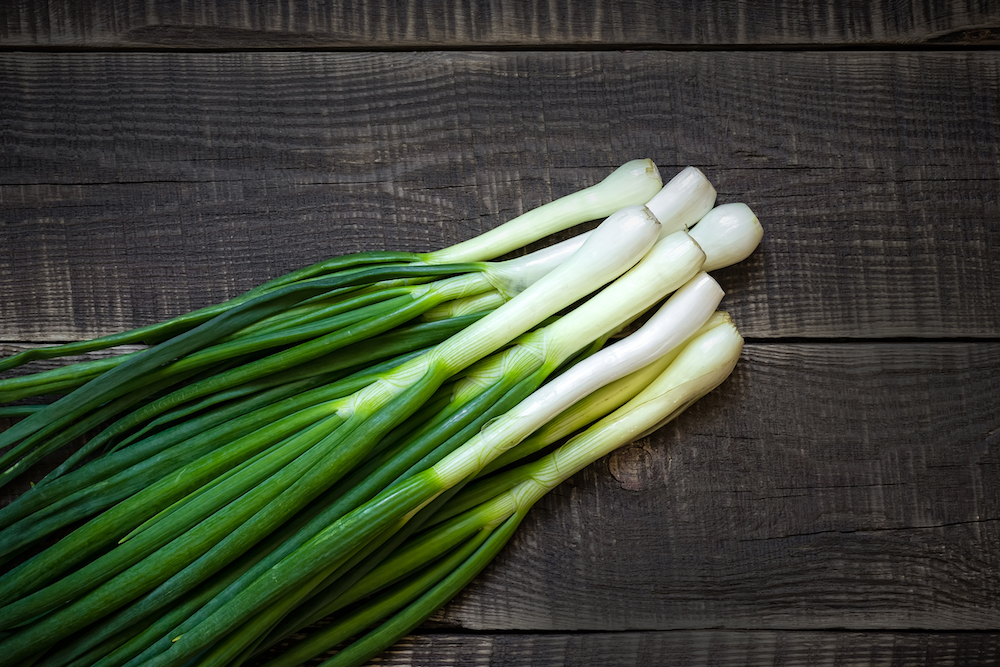Onions Go Green
Scallions—a versatile, verdant veggie—find a tangy place in cuisines all over the world.

Want onions that won’t make you cry? Stronger than chives but milder than most other onions, scallions— alias green onions—just may fit the bill. They’re young plants of the Allium genus that haven’t formed a full bulb. (Some varieties can’t.) They have long, tubular green stems, are sold nestled in bunches and can be served cooked or raw. Chefs have the option of using the bulbous bottom of the vegetable, the hollow green top or—for boosted nutrition and flavor—the entire stem. Adding a sprinkle of chopped scallions to a dish right before serving can provide a mild onion flavor, a hint of texture, a burst of bright green color and several notable health benefits.
This slender veggie gets around. Scallions are grilled and sprinkled with salt in Mexico, ground for a condiment in the Philippines, munched as an appetizer in India and added— chopped—to mashed potatoes in Britain. And in the homes of Sephardic Jews in or from Iran or Afghanistan; they take on a special ritual function. In memory of the ancient days of slavery in Egypt, family members gathered for the Passover seder meal use long green onions to ceremonially whack each other.
POWER UP
Scallions pack a wallop nutritionally too. A little bit of them goes a long way not just in flavor, but in beneficial content. When a full cup of scallions (tops and bottoms) is used in a dish, it adds only about 30 calories and 0.2 grams of fat. With that comes an array of health-boosting vitamins and minerals, including vitamin C (31 percent of the recommended daily value) as well as vitamin A (20 percent of DV) and its related antioxidants, such as lutein, zeaxanthin, beta-carotene and retinol (the last two linked to skin and eye health). Scallions also have a respectable amount of fiber (10 percent of DV) and of the B vitamin folate (16 percent of DV), which promotes cell growth, along with less than 10 percent of DV of iron, calcium, potassium and manganese. Besides helping the body function at its best, studies have found that eating Allium vegetables may reduce the risk of various types of cancer, including colon, prostrate and stomach.
But the pièce de résistance is the vegetable’s potency of vitamin K (more than 250 percent of DV in one cup), which helps the blood to clot. In fact, sprinkling just a tablespoon of scallions over a dish as a garnish can offer 16 percent of DV of the vitamin.
BUY/STORE/SERVE
Scallions should appear bright, feel crisp and be free of any brown spots, wilting or yellow leaves. They can be stored for several days in the refrigerator when wrapped in plastic. Cooks Illustrated recommends refrigerating them upright in a container with a little water and topped with a plastic bag for ideal freshness.
Once you’re ready to use it, wash the vegetable well and peel the thin layer of skin off the unformed bulb before slicing off the bottom.
Chopped scallions offer a blast of flavor when served in eggs (add them to your favorite omelet) or rice, or when baked into biscuits. Sprinkle the raw tops thinly sliced over soups, salads and even on top of cooked fish marinated in an Asian sauce to add zing. A popular Chinese dish, cong you bing, is made by combining the scallion with flour and sesame oil to cook it into a flaky, crispy pancake— Marco Polo is said to have become fond of this treat during his travels.
But don’t be afraid to celebrate the scallion for its simplicity. Coat scallions with olive oil and grill or roast them for a sweet and savory side dish, or whizz them in a food processor for a zesty vinaigrette. Top Chef Masters judge and food writer Francis Lam earned Internet popularity for an addictive Cantonese ginger-scallion sauce recipe he published in Salon paying homage to a dish he loved in his childhood.
DID YOU KNOW? In Chinese households, scallions are used in tea to treat a variety of ailments, including fever and headaches, and as a sedative for children, according to Eileen Yin-Fei Lo’s book The Chinese Kitchen.

